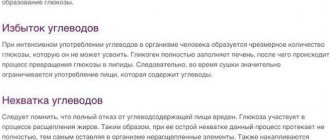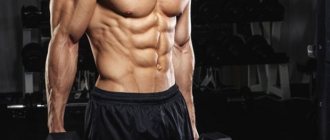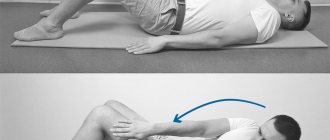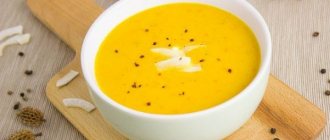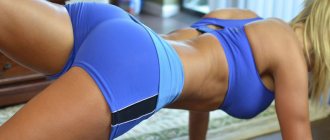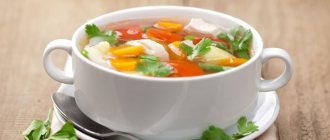Principles of drying for girls
To lose weight correctly, you need to adhere to the following drying principles:
- A diet aimed at burning fat should continue for 30-60 days. More precise timing depends on the initial thickness of the fat layer.
- You need to enter drying smoothly.
- You should eat in small portions, but at least 5-7 times a day.
- You need to drink at least 2 liters of water.
- You should count your calories throughout the day. The daily caloric intake depends on the woman’s age, her weight and physical activity. The average daily caloric intake is 1500 kcal.
- Sports should be regular. Strength exercises should be combined with aerobic training.
- Carbohydrate foods should be sharply limited. But it is necessary to reduce its volume gradually, and not sharply.
- Breakfast should be hearty.
- Dishes can be prepared in any way except frying.
- The menu should limit flour and sweet foods.
- Fats should be excluded, but they cannot be completely abandoned. The best source of fat is vegetable oil.
Recommendations
Diet for women over thirty includes the inclusion of those foods that are prohibited among professionals and young girls, namely dairy products, fatty fish, vegetables and fruits. Taking into account the peculiarities of age-related changes, the menu will promote weight loss, but at the same time ensure the supply of all fatty acids, microelements and vitamins necessary at this age, for example, Omega-3, calcium, vitamins B, A, E. You should not give up all foods suddenly , the main thing is to gradually enter and exit drying. After the results are obtained, add one new product every three to four days. A sudden return to your usual diet will only harm the body, and the extra pounds will return immediately.
Body drying menu for girls for a month
First week
In the first week of drying carbohydrates per day, you should receive 2.5 g per 1 kg of weight. They can be obtained from cereals (brown rice and buckwheat), from vegetables and fruits.
The menu is based on the following products:
- Every other day you need to eat fish.
- Chicken breast is used as meat.
- Cheese is rarely eaten, but kefir and cottage cheese are often consumed.
- Fresh vegetables, lettuce and herbs must be present on the table.
Vegetable oils and lemon juice should be used as a salad dressing.
Menu for the first week of drying:
| 1 meal | 2 meals | 3 meals | 4 meals | |
| 1 | Sea bass – 150 g; Buckwheat – 30 g; Grapefruit – 50 g. | Boiled eggs – 2 pieces; Milk – 1/3 cup. | Steamed chicken and rice cutlets – 190 g; 1/3 part of tomato; 3 olives. | Orange – ½; Cottage cheese – 0.25 kg. |
| 2 | Omelette of three chicken eggs; Milk – 100 g. | Vegetable Salad; Turkey fillet – 150 g; Berries – 20 g. | Perch – 170 g; Broccoli – 140 g; Lemon – 3 slices. | 0.4 liters of kefir. |
| 3 | Omelet from 3 chicken eggs. | Greens - a whole bunch; Pike perch – 150 g; Grapefruit. | Minced veal cutlets – 100 g; Boiled rice – 30 g. | Cottage cheese – 0.3 kg; One carrot. |
| 4 | Steamed chicken cutlets – 160 g; Half an orange; Boiled buckwheat – 70 g. | Vegetables and pike perch – 0.2 kg; Tomatoes – 20 g; Rice – 50 g. | Vegetable salad with vegetable oil – 150 g. | Kefir – 150 g; Grapefruit – 50 g; Tea and honey. |
| 5 | Omelette made from one yolk and three whites; Berries – 50 g. | Cabbage soup – 250 g; Boiled beef – 70 g; Greens – 1 bunch. | Seafood – 0.2 kg; Half an orange. | 0.3 kg cottage cheese; Grapefruit – 50 g. |
| 6 | Oatmeal with dried fruits – 30 g. | Greek salad – 30 g; Chicken fillet – 0.3 kg. | Fresh cabbage salad – 40 g; Boiled pike perch – 170 g. | Orange; 0.2 kg of cottage cheese. |
| 7 | Steam omelet based on 2 eggs; Grapefruit. | Chicken fillet; Brown rice – 30 g; Juice – 100 g; A bunch of greenery. | Seafood and lemon – 0.2 kg. | Cottage cheese with berries – 0.3 kg; Tea with honey. |
Second week
In the second week of drying, the amount of carbohydrates should be limited to 1 g per 1 kg of weight. These products should be consumed in the first half of the day.
Menu for the second week of drying:
| 1 meal | 2 meals | 3 meals | 4 meals | |
| 1 | 0.3 kg cottage cheese; 0.3 liters of tomato juice; Three boiled eggs. | Vegetable salad – 150 g; Chicken fillet – 180 g; Drinking yogurt – ½ cup. | Boiled pike perch fillet 0.2 kg; Juice – 0.2 l. | Cottage cheese and berries – 0.3 kg. |
| 2 | Cottage cheese – 0.15 kg; Nuts – 20 g. | Chicken fillet – 0.21 kg; Cauliflower – 90 g; Brown rice – 20 g. | Pollock – 180 g; Buckwheat – 20 g; Orange – 20 g. | Kefir 0.2 l. |
| 3 | Three egg omelette; Tea with honey. | Tomato – 20 g; Brown rice – 20 g; Chicken fillet – 0.3 kg. | Seafood with lemon juice – 0.15 kg. | Cottage cheese – 0.3 kg. |
| 4 | Two boiled eggs; 0.2 liters of kefir. | 0.3 l broth; Minced chicken dumplings – 0.18 kg; Tomato – 60 g. | Perch – 150 g; Buckwheat – 20 g; Greens – 1 bunch. | 0.25 kg of cottage cheese with berries. |
| 5 | Omelet with 3 whites and one yolk; Berries – 50 g. | Cabbage soup – 0.25 l; Boiled beef – 0.17 kg; Greens – 1 bunch. | Seafood – 0.2 kg. Half an orange. | Cottage cheese – 0.3 kg; Grapefruit – 50 g. |
| 6 | Omelet made from 2 steamed eggs; Grapefruit. | 180 g minced chicken quenelles; ½ cup yogurt; 100 g Greek salad. | Lemon – 2 slices; Seafood – 0.2 kg. | Cottage cheese with berries 0.3 kg. |
| 7 | Whole orange; 3 egg omelette. | Perch fillet; Greek salad – 80 g; Buckwheat – 30 g. | Chicken fillet – 0.33 kg; Whole grapefruit. | Cottage cheese – 0.3 kg. |
Third week
In the third week of drying, the amount of carbohydrates consumed per day must be further reduced - to 0.5 g per 1 kg of weight. In addition, fruits are completely excluded from the menu.
Menu for the third week of drying:
| 1 meal | 2 meals | 3 meals | 4 meals | |
| 1 | 0.28 kg cottage cheese; Three egg omelette. | 0.15 kg chicken fillet; Chicken puree soup – 0.2 l with olive oil; Greens – 1 bunch. | Seafood – 0.2 kg; Lemon – 2 slices. | 0.3 liters of kefir. |
| 2 | Tomato – 1/2 pcs; Boiled eggs – 2 pcs. | Minced veal cutlets – 0.2 kg; Buckwheat – 20 g; Green salad – 20 g. | Lightly salted salmon – 0.2 kg; Greens – 1 bunch. | Cottage cheese – 0.325 kg; Nuts – 5 g. |
| 3 | Steamed minced fish cutlets – 0.2 kg; Rice – 20 g. | Broth – 0.3 l; Fillet – 0.3 kg; Greens – 1 bunch. | Seafood – 0.2 kg. Green leaf lettuce – 1 leaf. | Cottage cheese – 0.25 kg; Kefir – 0.3 l. |
| 4 | 3 egg omelette; Tea with honey. | Steamed minced turkey cutlets – 150 g; Broccoli – 80 g; Greens – 1 bunch. | Perch – 0.25 kg; Buckwheat – 20 g; Tomatoes with oil – 20 g. | Kefir – 0.3 l. |
| 5 | Boiled eggs – 3 pcs. | Fillet – 0.3 kg; Brown rice – 20 g; Greens – 1 bunch. | Seafood – 0.2 kg; Lettuce leaf with oil. | Cottage cheese – 0.3 kg; Nuts – 10 g. |
| 6 | 0.3 kg cottage cheese; Tea with honey. | Cabbage soup – 0.3 l; Minced turkey cutlets – 150 g. | Lightly salted salmon – 0.2 kg; Lettuce leaf. | Kefir – 0.3 l. |
| 7 | Three egg omelette; Tea with honey. | Lettuce leaves; Perch; Buckwheat – 20 g. | Vegetable salad – 100 g; Fillet – 0.3 kg. | 0.3 kg of cottage cheese. |
Fourth week
In the fourth week of drying, carbohydrate foods are reduced to a minimum. You are allowed to eat no more than six spoons of porridge per day. You can't eat carrots.
Menu for the fourth week of drying:
| 1 meal | 2 meals | 3 meals | 4 meals | |
| 1 | Three boiled eggs. | 0.5 liters of broth; Minced veal cutlets – 0.18 g; Tomato – 20 g. | Perch and greens – 0.2 kg; Porridge – 10 g. | Kefir – 0.2 l; Cottage cheese – 0.3 kg. |
| 2 | Salmon – 0.3 kg; Vegetable salad – 150 g. | 0.3 kg fillet; Vegetable salad – 150 g. | 0.3 kg of seafood, lettuce leaves. | 0.3 kg cottage cheese; Nuts – 10 g. |
| 3 | Three egg omelette; Tea. | 0.2 kg minced chicken quenelles. | Perch – 0.25 kg; Leaf lettuce – 1 leaf; Nuts – 20 g. | Low-fat yogurt - a glass. |
| 4 | Boiled eggs – 2 pcs; Fillet – 100 g. | Salmon – 0.2 kg; One lettuce leaf. | Steamed minced turkey cutlets – 0.15 kg; Greek salad – 50 g. | Kefir – 0.3 l; Cottage cheese – 0.2 kg. |
| 5 | Three egg omelette and a glass of tea. | Chicken broth – 0.4 l; Perch – 0.15 kg; Broccoli – 30 g. | Fillet – 0.33 kg; Greek salad – 30 g. | Cottage cheese – 0.3 kg; Greek salad – 50 g. |
| 6 | 20 g rice; 0.25 kg fillet. | 0.3 kg salmon; Lettuce leaf. | Cottage cheese – 0.4 kg. | Kefir – 0.2 l. |
| 7 | Three boiled eggs and a glass of tea with honey. | 0.15 kg of minced chicken quenelles; Rice; Greens – 1 bunch. | Perch with lemon – 0.25 kg; Lettuce leaf. | Cottage cheese – 0.3 kg. |
How much protein per 1 kg of body should girls eat?
During the period of drying the body, 80% of the diet should consist of proteins. Including a large amount of protein foods in your diet helps you get rid of excess subcutaneous fat, while maintaining muscle mass. Girls need to consume 1.5-2.5 g of protein per 1 kg of weight, with the bulk (approximately 70%) of proteins being of animal origin.
Such proteins are easier to digest and are almost completely used by the body. In addition, animal protein contains all eight essential amino acids that are necessary for the body to function properly. Heavy proteins (for example, beef) are best consumed during the period of gaining muscle mass, and during cutting, lighter proteins will be more beneficial.
Main products containing these proteins:
- eggs;
- chicken;
- cottage cheese;
- fish.
The diet should be prepared taking into account the fact that light proteins, vegetables and greens should be left for the evening meal. The predominance of proteins in the diet reduces the natural feeling of hunger. Unlike carbohydrates, they take a long time to digest and give you a feeling of fullness for a long time.
BZHU calculation formula
To calculate your metabolic rate, you will need the following steps:
- Women: 655 + (96*weight/kg) + (1.8*height/cm) – (4.7*age in years).
- Men: 66 + (13.7*weight/kg) + (5*height/cm_ - (6.8*age in years).
The resulting figure must be multiplied by the activity coefficient:
- If a person leads a sedentary lifestyle and moves little, then multiply by 1.2.
- If a person plays sports 1-3 times a week, but the loads are not too intense, then you will need to multiply by 1.38.
- If a person trains 1-5 times a week, and the loads are moderate, then he will need to multiply by 1.55.
- When physical activity is high, you need to multiply by 1.73
You must subtract 500 from the resulting value. The final figure will characterize the daily calorie content.
The next step is to calculate the calorie corridor:
- To determine the minimum daily caloric intake, subtract 250 from the daily caloric intake.
- To determine your maximum daily calorie intake, you need to add 100 to your daily calorie intake.
For example, if a person’s average daily caloric intake is 1600, then he cannot gain more than 1700 kcal and less than 1350 kcal.
The last step is to calculate the amount of proteins, fats and carbohydrates. One gram of protein and carbohydrates contains 4 kcal. One gram of fat contains 9 kcal. You should consume 30-35% protein, 15-20% fat and 45-50% carbohydrates per day.
The calculation is done as follows:
- Protein:
- Minimum level: (1350 * 0.3) / 4 = 101 g.
- Maximum level: (1700 * 0.35) / 4 = 148 g.
- Fats:
- Minimum level: (1350 * 0.15) / 9 = 22 g.
- Maximum level: (1700 * 0.2) / 9 = 37 g.
- Carbohydrates:
- Minimum level: (1350 * 0.45) / 4 = 151 g.
- Maximum level: (1700 * 0.5) / 4 = 212 g.
Drying the body after 40 years - nuances
To undergo body drying after 40 years, you will need to create a nutrition program with a menu for 14-28 days. Regular physical activity is no less important at this age.
After 40 years, you should reduce the amount of carbohydrates you consume a little more. You need to enter the diet very carefully, as well as exit it.
In addition to the standard menu, you can use nutritional supplements designed for athletes. For example, it could be: Yohimbine, Acetyl L-carnitine, Express.
What is body drying?
Athletes bodybuilders know very well how and why they cut. This is a necessity before competitions.
But many non-professionals consider this a method of quickly losing weight. Let's figure out what's what.
The main task of cutting is to remove subcutaneous fat and maintain muscle mass. Drying is a complex consisting of a special low-calorie diet and highly effective training. Changing your diet without appropriate exercise will not have the desired result. In addition, modern research claims that physical activity helps cope with chronic stress and prevents the development of depression. If you feel anxious, restless, insecure, or lonely, download our guide “How to Overcome Stress”, which will help you find inner answers and better understand yourself.
It should be noted that due to the physiological characteristics of the male and female body, the methods of achieving drying will differ. The female body is more susceptible to the appearance of subcutaneous fat. And this is natural. This is due to the function of possible motherhood. Therefore, in this article we will only talk about drying the body for women.
In the topic: how to pump up your abs / how to pump up your butt
The nature of the appearance of subcutaneous fat is simple. The human body needs energy to function normally. He gets it from food. When the diet is balanced and there is no excess of calories, then proteins, carbohydrates and fats, when broken down, provide the body with enough energy. When there is an excess of carbohydrates in the diet, the body begins to create reserves in the form of subcutaneous fat from the remaining excess. Therefore, special diets for weight loss have been developed, which are called low-carbohydrate diets.
List of allowed and prohibited products for drying the body
The cutting diet should include proteins, fats and carbohydrates, but with an emphasis on the first component. Fast carbohydrates should not be on the menu.
Authorized products:
- Any fish.
- All vegetables except potatoes and legumes.
- Any meat: chicken, turkey, beef, veal, lamb, rabbit and nutria.
- Milk, cottage cheese, kefir, yogurt, tofu cheese.
- Seafood.
- Chicken egg white.
- Greenery.
Limited consumption products:
- Boiled potatoes in their jackets, baked potatoes.
- Durum pasta.
- Cereals.
- Nuts and dried fruits.
- Berries.
- Low-fat cheeses.
- Chicken egg yolk.
- Legumes.
- Wholemeal bread.
Prohibited products:
- Bread made from wheat flour and other flour products.
- Sweet.
- Pasta made from soft wheat varieties.
- Mayonnaise.
- Canned foods.
- Smoked products.
- Sausage.
- Processed cheese.
Allowed body drying products for women
In order for drying the subcutaneous fat layer to successfully achieve the desired result, the basis of the diet during this period is food that contains more proteins and carbohydrates.
During the day, you can include the following protein-rich foods without restriction in any meal:
- egg white - fresh or boiled;
- cottage cheese with a fat content of no more than 5%;
- chicken or turkey meat (preferably breast meat) boiled or steamed;
- beef, veal, boiled or in the form of steam cutlets;
- steamed white fish fillet (pollock, cod, tilapia);
- squid fillet;
- fermented milk products (kefir and yogurt 1%).
To regulate the metabolic process, girls during a diet when drying their bodies should stick to eating foods containing complex carbohydrates in the menu.
These products include the following:
- oatmeal, buckwheat or rice, boiled in water;
- pasta made from high-quality wheat flour;
- legumes (peas, lentils, beans), prepared in the form of soups or main courses;
- vegetables (tomatoes, cucumbers, peppers, zucchini, pumpkin, turnips, carrots, cabbage, beets, celery), fresh, stewed, boiled or steamed;
- fresh greens.
The diet for drying the body for girls should include small amounts of vegetable oil (olive, flaxseed) on the menu - exclusively as a salad dressing, as well as tonic drinks (tea with ginger or green).
Be sure to drink still or boiled water - in a daily volume of at least 2 liters.
Delicious and healthy recipes
Greek salad
To prepare the dish you will need the following components:
- One lemon.
- Two teaspoons of dried oregano.
- Three teaspoons of minced garlic.
- A teaspoon of basil.
- Two tablespoons of wine vinegar.
- One romaine lettuce.
- A cup of olive oil.
- Two tomatoes.
- Cucumber, green pepper and red onion – 1 pc.
- 0.2 kg Feta cheese.
- A cup of olives.
- Salt and pepper to taste.
To prepare the sauce, you need to mix lemon juice with oregano, garlic, olive oil, wine vinegar and sugar. To obtain a uniform consistency, whisk the sauce and cool.
Vegetables are cut, placed in a salad bowl, poured with sauce, kept for a quarter of an hour and served.
Sea bass
To prepare the dish you will need the following components:
- 4 stalks of green onions.
- A bunch of cilantro.
- A clove of garlic.
- One lime.
- One Jalapeño pepper.
- 1/4 cup lime juice and the same amount of olive oil.
- A teaspoon of honey.
- Two tablespoons of vegetable oil.
- 1.5 kg sea bass.
- Three tablespoons of flour.
You can serve corn tortillas with the dish.
Separately mix jalapeno, garlic, lime zest, cilantro, onion, olive oil, salt, and honey.
The perch is rubbed with pepper and salt, rolled in flour and fried in a preheated frying pan. After frying is finished, the fish is poured with the prepared sauce and served with flatbread.
Chicken with broccoli and almonds
To prepare the dish you will need the following products:
- 0.35 kg chicken fillet.
- 0.5 kg of broccoli.
- Chili flakes – 1/2 teaspoon.
- Roasted almonds – 0.1 kg.
- A teaspoon of sesame oil.
- Salt, pepper and olive oil to taste.
Chicken fillet is coated in seasonings, fried in a hot frying pan, then cooled and cut into strips. Broccoli is boiled in boiling salted water for several minutes. Fry them in olive oil along with chili flakes, add chicken fillet and almonds at the end of frying. The dish is poured with sesame oil, salt and pepper. Fry for another two minutes.
Shrimp with garlic and honey with broccoli garnish
To prepare the dish you will need the following products:
- 0.45 kg shrimp.
- Two tablespoons of garlic.
- A teaspoon of ginger root.
- Half a cup of honey.
- 1/4 cup soy sauce.
- 1.5 cups of broccoli.
Mix garlic, honey, ginger and soy sauce - this is a marinade for shrimp, but you don’t need to take all of it, but only 1/3 of it. Marinating time is 60 minutes. Stew broccoli in two tablespoons of sauce for five minutes. The shrimp are stewed there for minutes. When the shrimp are cooked, add the broccoli again and heat for another 3 minutes. The finished dish is poured with the remaining marinade.
Chicken fillet with asparagus and lemon wedges
To prepare the dish you will need the following products:
- 0.4 kg chicken fillet.
- 1/4 cup flour.
- 4 tablespoons butter.
- 2 cups asparagus.
- 2 lemons.
- 2 tablespoons of honey.
- To taste: salt, pepper, lemon pepper seasoning.
- For decoration you need chopped parsley.
Beat the chicken until the fillet is 1 cm thick. Dip the fillet in flour with salt and pepper, fry in butter for three minutes on each side, sprinkle with lemon pepper on top.
Asparagus is simmered in a frying pan until it turns a bright green color. Remove the asparagus, then fry the lemon in butter for two minutes. Now place asparagus, chicken and lemon in layers in the pan again and heat thoroughly. You can top the dish with sauce. To prepare it, honey is melted together with butter, in the same fat that remains after frying the chicken and lemon. This will give the dish a lemony taste.
Nutrition for a flat tummy
The duration of drying should not be less than a month or more than two. Even the slightest deviation from the plan can ruin all your efforts. So don't expect to get a flat stomach in a week, otherwise you will be deeply disappointed. Let's take a closer look at the diet and workouts for drying the stomach and sides.
A well-designed diet is 75% the key to success. Observe the following rules:
- The transition to a diet should be gradual. Think about your meals in advance and schedule them for the week. The first and last week should be the same menu.
- The number of calories expended should exceed the calories consumed. But under no circumstances should you try to fast.
- Meals should be very frequent, up to 7 times a day, approximately every two hours. This will help speed up your metabolism and make fat burning more efficient. Portions should naturally be small.
- Try to eat the same foods, distributed in a certain order, and purchase electronic scales to weigh portions. This will make it easier for you to control your calorie intake.
- Eat protein foods, reduce carbohydrates and fat to a minimum. Do not fry or season with sauces, and reduce salt intake. Boil or steam.
- Be sure to drink plenty of clean water from 2.5 to 4 liters per day. This will help relieve stress on the liver. It is better to replace coffee with green tea, because it has a tendency to remove water from the body, and during drying you do not need this.
- You need to completely give up unhealthy fast food, sweets and starchy foods. Their consumption provokes spikes in insulin in the blood, and this is fraught with the deposition of food into fat. Sweets can be replaced with fruits, but in small quantities.
- You don't need to stick to a carbohydrate-free diet. You should focus on complex carbohydrates and eat them in the morning.
- Avoid drinking alcohol while drying. If you are still smoking, quit.
- Do not overeat before bed; heavy food interferes with the normal functioning of the body and the burning of fat at night.
- Add protein sports nutrition and vitamin and mineral supplements to your diet. This will help balance your menu and eliminate the loss of nutrients along with fat.
- There is a great article on my blog that will also help you choose the best women's fat burner and other supplements for yourself. I recommend you study!
During a diet for drying the belly, the menu should include:
- Cereals and whole grain bread.
- Eggs (mostly white, but you shouldn’t be afraid of yolks and exclude them completely).
- Low fat cottage cheese, kefir, natural yogurt.
- Fruits - apples, oranges, grapefruits.
- Greens and vegetables, with the exception of potatoes.
- Lean meat, it is better to choose chicken breast or veal.
- Seafood and fish.
- Nuts, seeds, sesame in limited quantities.
- Dried fruits.
- Flaxseed or olive vegetable oil, as well as Omega-3.
As an option, you can take a closer look at the meat and vegetable diet. Many people use it successfully and are satisfied with the results. Please read the recommendations carefully before use.
Contraindications
Drying the body is unacceptable if the following contraindications exist:
- Liver diseases.
- Carrying a child.
- Diseases of the digestive system.
- Diseases of the urinary system.
- Diseases of the heart and blood vessels.
- Lactation.
- Diabetes mellitus and other pathologies of the endocrine system.
Who needs body drying and how it differs from losing weight
The method of drying the body in order to reduce the amount of subcutaneous fat is most often used by professional athletes. After all, it is impossible to be at the same weight and physical shape all year round. Therefore, bodybuilders first gain weight, and after a while they begin to “dry out.” The process of gaining weight allows you to build muscle, and drying gets rid of the fat layer, forming a beautiful relief.
However, drying the body is relevant not only for professional athletes. It is also useful for people who have problems with excess weight. Since only an integrated approach will help you get rid of extra pounds. A well-structured nutrition system and an appropriate training program.
Please note that professional body drying differs from regular weight loss with a change in diet and regular physical activity. People who just want to lose weight are working for long-term results. Proper weight loss requires a long period of dieting and systematic exercise. Often, those who are predisposed to obesity have to adhere to certain dietary rules throughout their lives. This is how they manage to stay in shape.
When drying, a special menu is drawn up. All fat-containing foods are excluded from the daily diet, the amount of carbohydrates is reduced to a minimum (or also eliminated), and salt is removed. Sticking to such a diet for a long time is not recommended. Otherwise, instead of the expected benefit, you can only harm the body. Lost weight will be returned in double volume, which is explained by the slowdown of metabolic processes during fasting.
Therefore, unlike the usual getting rid of extra pounds, which should take place smoothly and systematically, without any special prohibitions on a variety of foods, drying the body should be short-lived.
Recommendations for girls on drying at home
In order for body drying carried out at home to be effective, you must adhere to the following recommendations:
- You need to eat every 2-3 hours, which will avoid sudden surges in blood sugar levels.
- You need to drink clean water every hour. To calculate the volume of water you should drink per knock, you need to multiply your weight by 0.03.
- Every day you need to monitor the calorie content of the foods you eat.
- Every fifth day should be made carbohydrate. At this time, you should increase the amount of carbohydrate foods consumed, which will prevent the burning of muscle mass.
- Women can dry for 12 weeks, and men for 8 weeks. If drying is practiced for the first time, its duration should not exceed 5 weeks.
- Be sure to exercise while drying.
- When the amount of carbohydrates consumed decreases, you need to increase the amount of protein food to 2-3 g per 1 kg of body weight.
- In order to prevent disruptions in metabolic processes, it is necessary to reduce the daily calorie intake gradually, and not sharply: by 200 kcal in 7 days, but no more.
- Taking vitamin-mineral complexes will help avoid slowing down metabolic processes.
- If the weight has risen, then the body should give the body a two-day “carbohydrate boom”. This activates the thyroid gland.
- You should avoid fast carbohydrates, such as soft wheat pasta or white rice.
- To speed up the process of burning fat, you need to completely give up carbohydrate foods once every 7 days.
- Taking casein protein will prevent you from feeling hungry and will prevent the development of catabolism.
- Before each workout, you need to take L-carnitine. This will increase the number of kilocalories burned by 2 times.
- On days leading up to training, you should not sharply limit the amount of carbohydrates you consume.
- Before training, you need to eat slow carbohydrates or drink whey protein.
- Once a day you need to eat a portion of fatty fish. A serving does not contain more than 200 kcal, but the fats that are part of it have a positive effect on the process of losing weight.
- Dinner should consist mainly of protein foods. You can completely replace these products with casein protein and low-fat milk.
Diet for drying the body
What kind of nutrition should you choose to remove subcutaneous fat and maintain muscle mass?
Very often, drying is confused with regular weight loss. Without muscle mass, they go on fast diets. The result does not live up to expectations, since it was not possible to achieve a sculpted body. It should be understood that cutting should be done only if there is muscle mass.
In simple terms, you need to increase the amount of protein to maintain muscle mass. At the same time reduce your carbohydrate intake , thus creating a calorie deficit.
With a lack of incoming energy, the body begins to look for alternative resources. These will become fat reserves. A process starts when the source of energy in the body becomes not glucose, but fat cells. A low-carb diet is built on this principle.
- Low carbohydrate diet. Scientists developed it using the glycemic index of foods - GI. And it was proposed for the treatment of diabetes and obesity. Soon, many CrossFitters began to actively use this diet. The diet does not exclude carbohydrates, but suggests consuming only those foods that have a low GI and take a long time to break down into glucose.
- Protein diet. With a protein diet, the diet should have a ratio of proteins and carbohydrates of 80 to 20. This diet gives a sharp weight loss. But then the process slows down.
Many people make a big mistake by completely eliminating carbohydrates from their diet. Or they start eating only vegetables and fruits, hoping that this way they will successfully lose weight. Losing weight will lead to loss of muscle mass. And this has nothing to do with drying. And a lack of carbohydrates in the body can cause weakness and fatigue. The athlete does not need this at all.
Excessive protein consumption can also negatively affect your health. Especially on the functioning of the kidneys and cardiovascular system.
In nutrition during drying, it is important not only What you eat, but also How.
- Meals should be fractional. At least 5-6 times a day. It is enough to consume up to 300 calories at one time. The main task of fractional nutrition is to maintain a fast metabolism. Have time to burn and not accumulate unnecessary things.
- Keep your weight loss rate to no more than 0.5 - 1 kg per week. This way you will maintain muscle mass.
- time is up to 8 weeks. Yes! Be patient. Ratio: proteins 55%, carbohydrates 35%, the rest fats.
- Don't forget about water. This is an important aspect when drying, no matter how contradictory it may sound. The more water you consume, the easier it is for your body to part with it. When there is a shortage of fluid intake, the body begins to retain it in the body. And this will negatively affect the functioning of the kidneys on a protein diet. Plus the liquid will help remove fat-soluble toxins.
- Eat food one hour before and one hour after your workout.
- Before 6 p.m., try to consume 80 percent of your daily diet.
- Try to keep a calorie diary. You can calculate the calories of your dishes on your smartphone or using a calorie calculator on websites.
Workouts during the drying period
To dry your body successfully, you need to train. And you can do this even at home.
To create a training plan, you must adhere to the following recommendations:
- Strength exercises should alternate with aerobic exercises.
- You need to do strength exercises twice every 7 days and aerobic exercises three times. Examples of the most effective aerobic exercises: swimming, running, cycling, step aerobics, skipping rope, rowing, roller skating.
- Aerobic exercise is best done in the first half of the day, immediately after waking up.
- The pulse during training should be 120 beats per minute.
- The optimal training duration is 45 minutes - 1 hour.
- It is good to use a heart rate monitor during exercise.
- The body must recover. To do this, two days a week must be free from training.
- You should eat 2 hours before the start of classes and two hours after them.
Training plan
The presented training plan is designed to work the main muscle groups. It is suitable for beginners. Exercises should be performed 10-15 times, 3 approaches each. After two months, the number of approaches can be increased to four.
To start, you need to train three times a week, and then you can increase the number of sessions to four. The duration of one workout is 60 minutes. Subsequently, the time is increased to 90 minutes.
Workout 1.
You need to start your workout with a warm-up.
- Crunches while lying on the floor.
- Deadlift using dumbbells.
- Dumbbell press from a sitting and standing position.
- Squats with dumbbells.
- Bench push-ups from behind.
- Lunges with dumbbells.
- Bent-over dumbbell row.
- French press using dumbbells.
You need to complete the workout with a cool-down, which lasts 2-5 minutes.
Workout 2.
You need to start doing the exercises with a ten-minute warm-up.
- Raising legs from a lying position.
- Lifting onto a chair using dumbbells.
- Wide grip bench press.
- Stretching from a standing position with dumbbells.
- Bent-over dumbbell raises.
- Lunges with dumbbells.
- Side bends with dumbbells.
- Arm curl with dumbbells from a standing position.
- Calf raises with dumbbells.
You need to complete the workout with a 2-5 minute cool-down.
Drying gym workouts for girls
Both strength and oxygen loads can be carried out in the gym. Good complexes already have equipment for strength and cardio exercises.
Pros of working out in the gym:
- They will help you choose a training program, set the execution technique, and tell you the basics of the exercises.
- In the gym you can do both cardio and strength training.
- Stepping out of your comfort zone. When you find yourself in an unfamiliar environment, you will have to adapt to the environment. This develops strong-willed qualities, helps to become more self-confident and make new acquaintances.
- Availability of all necessary training equipment. You don't need your own dumbbells, barbells and much more.
- A change of scenery. You will be able to delimit action zones for yourself. Relax at home, work in the gym. From a psychological point of view, this is an important point. Some girls, and men too, find it difficult to relax and work in one place.
- Subscription fee. Yes, you spend money on buying a subscription, but now you have to earn back your investment. It will be more difficult to skip workouts.
Despite the excellent prospects, training in the gym also has its drawbacks:
- Constant trips to the gym. You must plan your time rationally in order to manage everything, everywhere.
- Crowds of people. At some times of the day, a lot of people come to the gym, which can lead to queues for the exercise equipment.
- Psychological barrier.
Training in the gym is suitable for absolutely everyone. It's up to you to decide how to practice.
Popular questions
- Why do girls need drying?
Most often, professional athletes who want to make their muscles more prominent resort to drying. However, drying is increasingly being practiced by ordinary people who want to get rid of excess weight. Experts do not recommend drying for unprofessional purposes or not according to the rules, so as not to harm the body.
- If I skip a meal, can I have two servings next time?
You can't do that. The calorie content of one serving should be no more than 300 kcal, and a maximum of 500 kcal. The body will not be able to expend more than this amount and will store excess calories as fat.
- Should carbohydrates be completely removed from the menu to increase cutting efficiency?
No, you shouldn't do that. If you refuse carbohydrate foods, metabolic processes will be disrupted. In addition, the body may begin to burn muscle. There is also a risk of developing ketoacidosis.
- Is drying harmful to health?
If you follow all the rules, drying will not harm your health. However, you can start training only if there are no contraindications.
- Which drying option is optimal for a girl?
The approach to drying the body should be comprehensive. Training should be combined with diet and sports nutrition.
- How many kilograms can you lose in 7 days of drying?
Average losses are 0.5-1.5 kg. The result largely depends on the initial weight. If it goes away faster, then you should eat more carbohydrate foods so as not to harm your own body.
- Will it be possible to dry it in 5 days?
Yes, it is real, but it is associated with health problems. The effect of such drying will be short-lived.
- How long can drying last without causing harm to health?
For girls this period is 12 weeks, and for men 8 weeks. In the future, the result must be maintained and consolidated with the help of training and menu restrictions.
Side effects of the drying process for girls
During drying, athletes feel a loss of strength, since due to the diet, the consumption of the main source of energy - carbohydrates - is reduced to a minimum. Also, obtaining a sufficient amount of substances useful for the body’s functioning is also reduced. There are problems with sleep, nervousness and irritability, and dizziness. Nevertheless, giving up carbohydrates can quickly reduce fat mass, however, due to the lack of an energy source - carbohydrates, and especially simple carbohydrates, the body begins to replenish energy reserves through protein molecules. If there is insufficient amount of protein received from the outside, that is, from food, the body will obtain protein by breaking down muscle fibers for energy.
